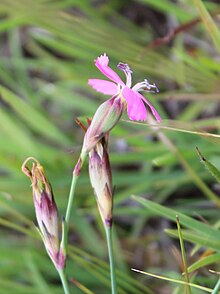| Dianthus basuticus | |
|---|---|

| |
| Dianthus basuticus flowers | |
| Scientific classification | |
| Kingdom: | Plantae |
| Clade: | Tracheophytes |
| Clade: | Angiosperms |
| Clade: | Eudicots |
| Order: | Caryophyllales |
| Family: | Caryophyllaceae |
| Genus: | Dianthus |
| Species: | D. basuticus |
| Binomial name | |
| Dianthus basuticus Burtt Davy | |
Dianthus basuticus, called the Drakensberg carnation, Lesotho carnation, Lesotho pink, hlokoa‑la‑tsela in the Sesotho language and Lesothose wilde angelier in Afrikaans, is a species of Dianthus native to South Africa and Lesotho.
Distribution
It is a near-endemic of the Drakensberg Alpine Centre, and occurs predominantly on rocky, grassy slopes, from Avontuur and the Kammanassie mountains in the Western Cape, through the Eastern Cape and into KwaZulu-Natal Province.
The northernmost records are from near Belfast and Pilgrim's Rest in Mpumalanga Province. Other records are from Kokstad and Newcastle, KwaZulu-Natal, as well as Harrismith and Clocolan in the Free State Province.
The subspecies fourcadei occupies the westernmost extent of the species distribution range, occurring in the mountainous Uniondale, Langkloof and Kouga regions, around the boundary between the Western and Eastern Cape provinces.
Description
Dianthus basuticus is a densely tufted perennial reaching 15–20 cm, with linear (50mm x 5mm) blue-grey leaves, densely clumped near to the ground.
The inflorescence is usually branched, and rises c. 15 cm above the main leaf tufts.
The flowers are usually dark pink, c. 20 mm wide, and appear in Summer-Autumn (Nov-Apr.). The petals are broad and obovate (those of most other South African species are narrower and oblanceolate) with only minutely toothed or serrated tips. The petals are sometimes slightly recurved.
The calyx is 15–20 mm in length, with 2-3 bract-pairs. The bracts are 15-20mm long.
-
 The Dianthus basuticus petals are only mildly or minutely serrated.
The Dianthus basuticus petals are only mildly or minutely serrated.
-
 Dianthus basuticus herbarium specimen
Dianthus basuticus herbarium specimen
References
- "Threatened Species Programme | SANBI Red List of South African Plants".
- "Dianthus basuticus Burtt Davy". Plants of the World Online. Board of Trustees of the Royal Botanic Gardens, Kew. 2017. Retrieved 23 August 2020.
- Carbutt, C.; Edwards, T.J. (2006). "The endemic and near-endemic angiosperms of the Drakensberg Alpine Centre". South African Journal of Botany. 72: 105–132. doi:10.1016/j.sajb.2005.06.001.
- Goldblatt, P. and Manning, J.C. (2000) Cape Plants: A conspectus of the Cape Flora of South Africa. Strelitzia 9. National Botanical Institute, Cape Town. p.460
- "Threatened Species Programme | SANBI Red List of South African Plants".
- Vlok, J. and Schutte-Vlok, A.L. (2010) Plants of the Klein Karoo. Umdaus Press, Hatfield. p.330
- Burtt Davy, J. (1922) XXXIII. A Revision of the South African Species of Dianthus. Bulletin of Miscellaneous Information 7. pp. 209-223. Royal Botanic Gardens, Kew.
| Taxon identifiers | |
|---|---|
| Dianthus basuticus | |